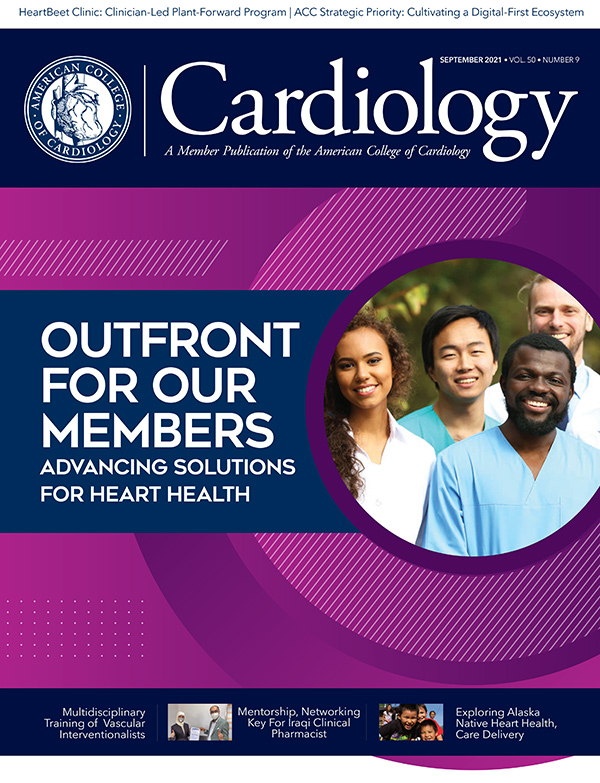ACC Quality Summit Preview: Quality in Imaging and Diversity With Dr. Pamela Douglas

A former president of the ACC, Pamela S. Douglas, MD, MACC, is known for her work in improving the quality of imaging in cardiovascular care, research and registries. In addition, Douglas has advocated for increased diversity and equity within the cardiology workforce and for efforts to address health disparities among patient populations. She served as chair of the ACC Task Force on Diversity and Inclusion and is a member of ACC's Health Equity Task Force.
Douglas will give the Ralph G. Brindis Lecture on Friday, Oct. 1, at ACC Quality Summit Virtual, addressing how NCDR and ACC Accreditation Services support health systems in providing quality care to cardiovascular patients. She recently spoke with Cardiology magazine about quality improvement in cardiology and how diversity and equity among the cardiology workforce can lead to better patient outcomes.
Please give a preview of your talk at Quality Summit.
I will be talking about quality in imaging. Since few in the audience are imagers, I'll be talking about how a patient is selected to have an imaging test and which test is done. What is the outcome of that test and the impact on care? It's the same type of process for choosing a nuclear stress test or echocardiogram stress test. How do we decide when a patient needs something? How do we choose what they need? Then we need to execute that procedure well. That's the sweet spot for NCDR, which largely focuses on quality in performance of procedures. Careful selection is needed to make sure the patient will improve by a well-executed procedure. All these things are important, but if you pick the wrong patient, it doesn't matter how good the procedure is. You're not going to have the right impact on outcomes. Picking the right patient and the right test for that patient is a more expansive view of quality.
In cardiology, what should we think about when we talk about quality improvement?
The sweet spot for quality improvement is when we have good evidence that is not being followed for some reason, or we have great variation in practice when we know what to do but it's all over the map as to what we're actually doing. It's important in quality improvement that we look at those places where there are clear evidence, and we can measure whether we're living up to what the evidence tells us we need to be doing.
What can nurses and CV team members on the ground do to improve quality and address disparities?
Health disparities and inequities exist at many levels. They exist when someone in a clinic calls a Black patient by their first name and a White patient as Mr. or Mrs. It's on all of us to treat our patients with respect, to treat them similarly, to honor their differences in how they seek medical attention, how they respond to it, and to their cultural and religious environment. In many ways, nurses or advanced practice providers, or even receptionists at the front desk, have the opportunity to ensure that all of our patients are treated equally and that all of their unique needs are met.
How can addressing diversity and inclusion in the cardiology workforce advance quality improvement?
Patients tend to prefer a provider of the same sex and the same race. There is a lot of data on race, particularly having an African American provider leads to trust on the part of an African American patient, helps the patient be more compliant with medications, and enables a better physician-patient relationship. If we only have a few Black physicians in our workforce and a significant proportion of our patient population or national population is Black, or perhaps more in many clinics because of the greater burden of disease, then we're missing the ability to connect with this demographic. Women physicians generally tend to spend more time with patients and are more attuned to psychosocial issues. If we don't have the representation of these individuals in our workforce, we will not be the best that we can be.
You've written and talked about equity in terms of opportunity in the workforce. How does addressing equity among clinicians benefit patient care?
We have good data about equity between men and women cardiologists. We have much less data about underrepresented minorities or groups that are underrepresented in cardiology. In addition to women cardiologists being paid less than men, they tend to have less resources or ability to use resources, and these things contribute to burnout. There is more burnout among women cardiologists than among men cardiologists. Burnout is bad for patients, ultimately. We all want to be treated by a happy, secure doctor who loves their job and who wants to be there taking care of patients.
Clinical Topics: Cardiovascular Care Team, Prevention, Stress
Keywords: ACC Publications, Cardiology Magazine, Physicians, Women, Exercise Test, Physician-Patient Relations, Quality Improvement, Health Equity, Cost of Illness, Population Health, Quality of Health Care, Burnout, Psychological, Accreditation, Registries, Demography, Family Characteristics, Patient Care, National Cardiovascular Data Registries
< Back to Listings

